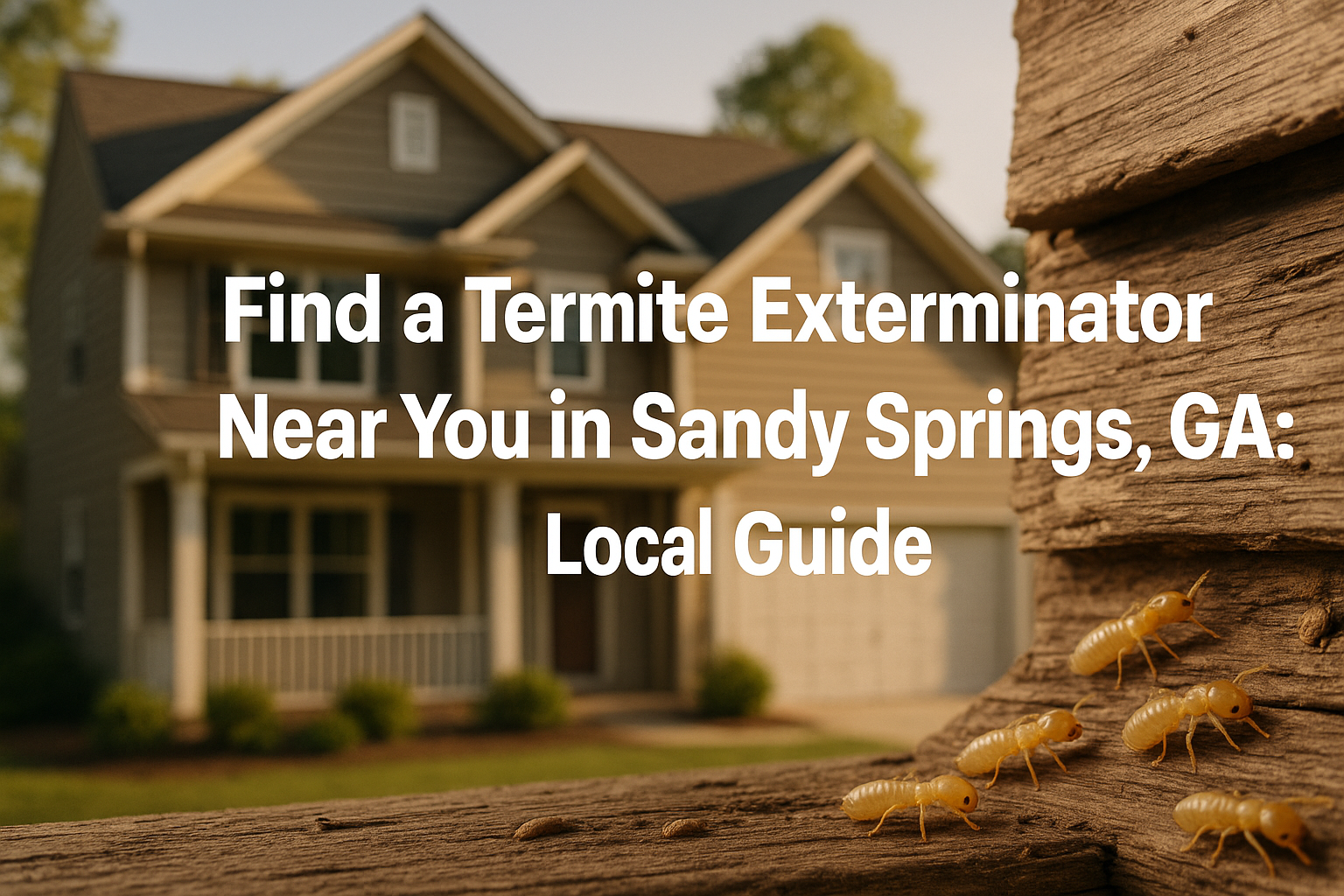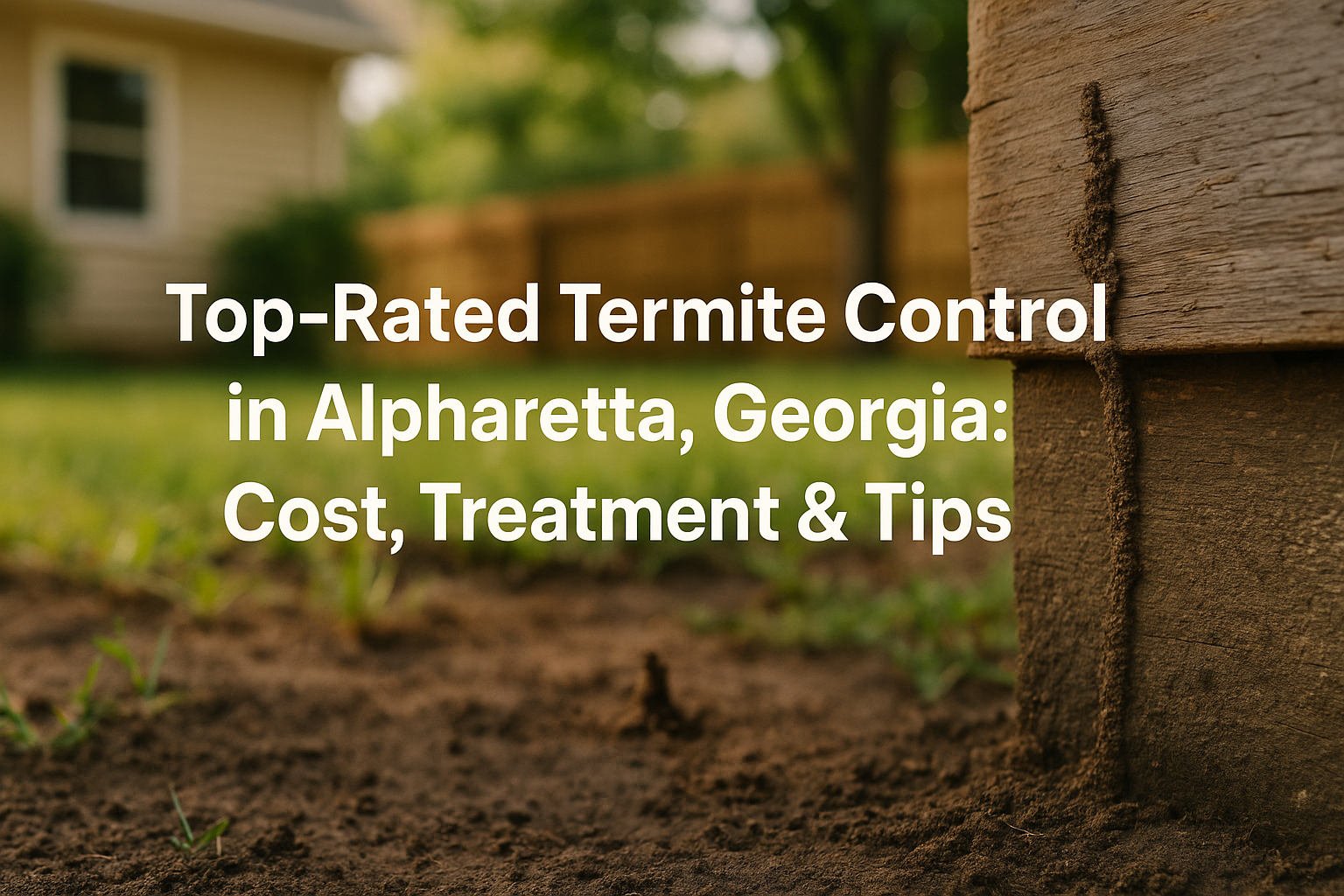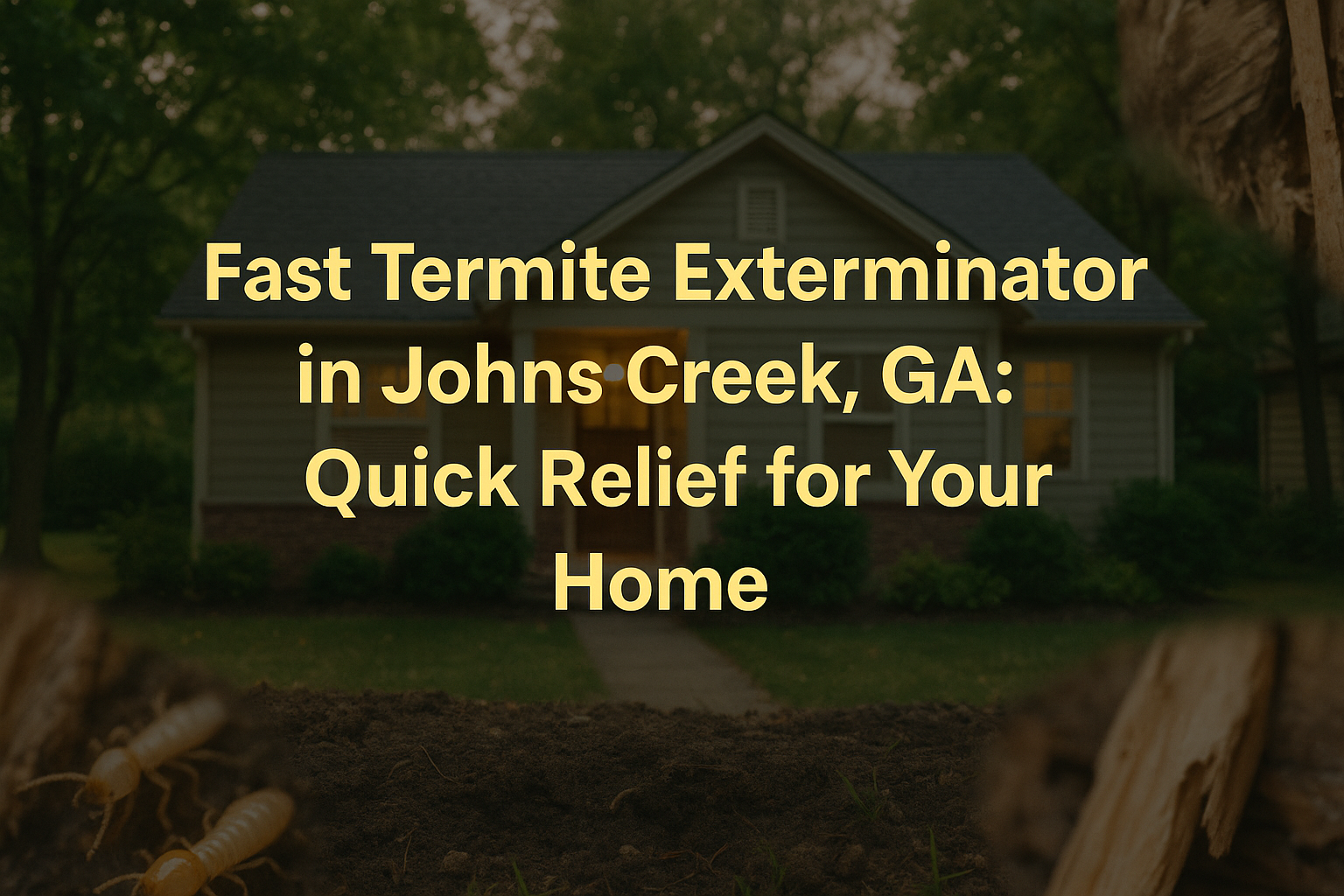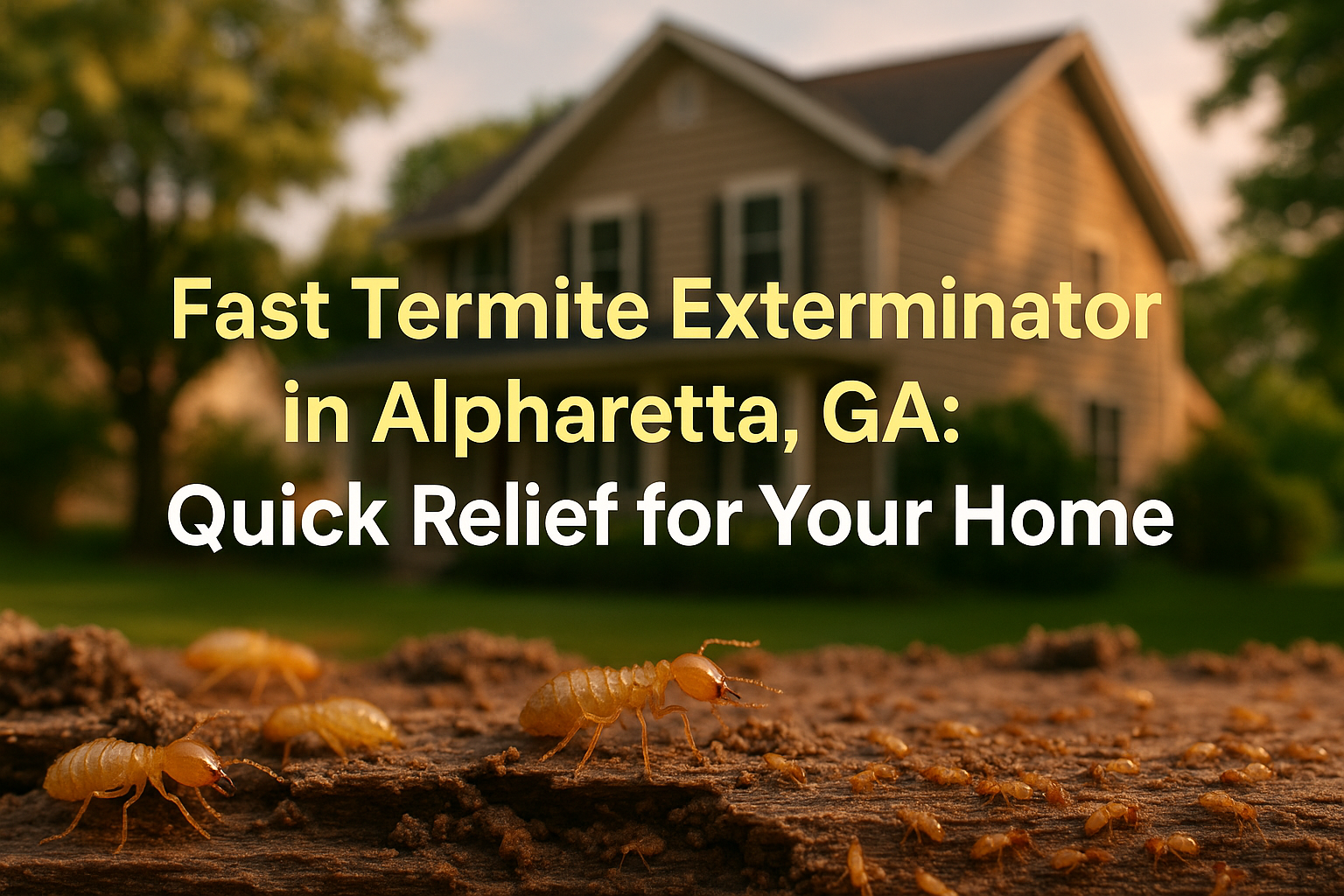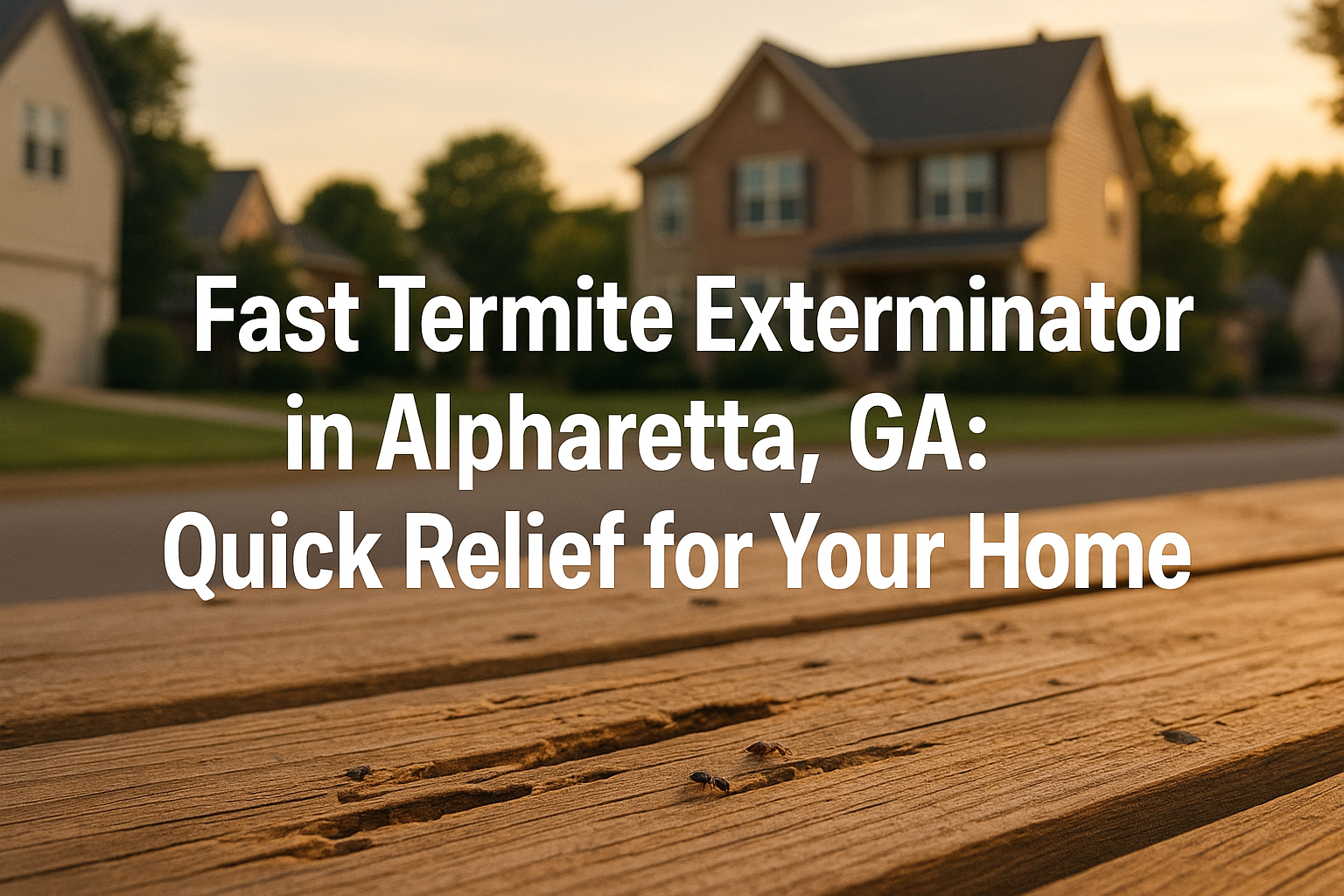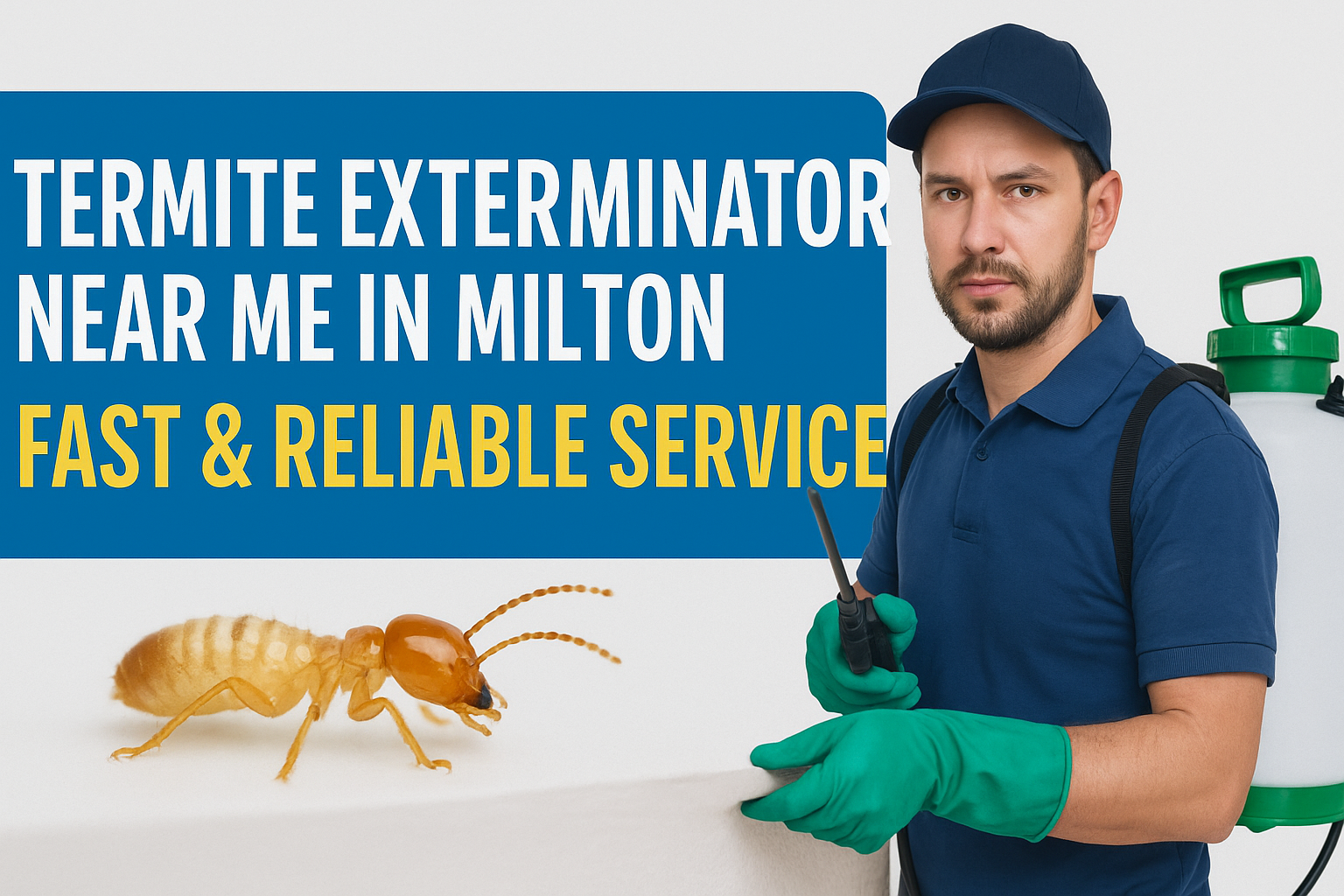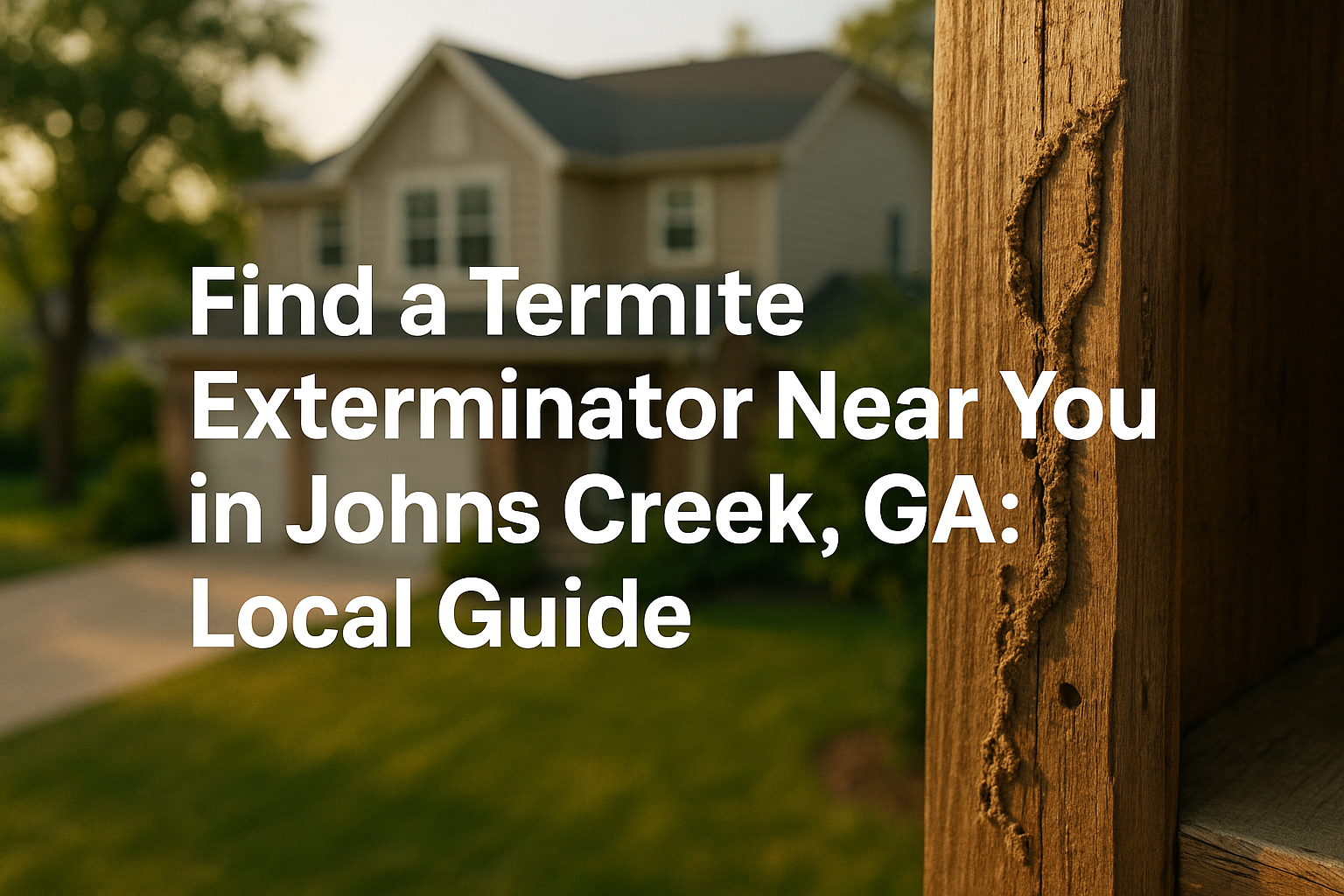Termites Are No Joke in Sandy Springs—Here’s Why You Need to Act Quickly
If you own a home here in Sandy Springs, there’s a good chance termites are closer than you think. These little destroyers don’t make much noise—until you realize they’ve chewed through thousands of dollars’ worth of wood, flooring, and even your home’s very foundation. Many homeowners searching for a termite exterminator near me only discover the problem once it’s already cost them a small fortune—on average, about $7,900 in repairs that insurance usually won’t touch.
Sandy Springs is prime termite country, thanks to our warm and humid weather paired with a mix of older houses and the new builds going up all over town. Certain neighborhoods like Riverside, Chastain Park, and North Springs face extra risk, especially if your home’s got wood framing, crawl spaces, or that classic Southern porch.
Once termites move in, your wallet isn’t just on the hook for damage, but for the cost of finding and getting rid of them too. Homeowners often start searching for a termite exterminator near me when the problem becomes visible. Inspections usually run from $90 to $350, while treatments to fully tackle an infestation can land anywhere between $800 and $2,500 or even more, depending on how bad it’s gotten. And trust us—waiting only gives termites more time to work under the radar.
This guide is here to save you time, stress, and money. We’ll cut through the noise and help you zero in on the best termite exterminators right here in Sandy Springs. You’ll get real numbers on what services truly cost, tips for spotting problems early, and steps you can take to help keep termites out for good.
It’s your home—don’t let termites turn it into lunch. Ready to dig into practical, proven solutions? Let’s work together to protect what matters most and make sure those hidden invaders don’t stand a chance.
What Goes Into the Cost of Termite Extermination in Sandy Springs?
If you’re staring down a termite problem in Sandy Springs, you’re probably wondering, “What’s this gonna cost me?” Many homeowners begin searching for a termite exterminator near me at this stage, but the honest answer is—it depends on quite a few things. It’s important to understand where your money’s going before you make your next move.
The main factor is scope. Simply put, bigger homes or bigger infestations mean a higher bill. If you live in a sprawling two-story near Aberdeen or Huntcliff and termites have set up shop in every nook and cranny, your quote will naturally be higher than for a small townhouse with a fresh problem.
How long those critters have been chomping away matters, too. A new, localized infestation is quicker — and cheaper — to fix than one that’s dragged on for months or years. In older neighborhoods, termites sometimes go unnoticed until there’s serious damage, which calls for more heavy-duty treatment. That can mean extensive chemical applications, follow-up visits, or even spot repairs to woodwork and crawl spaces.
Treatment type is another piece of the puzzle. Standard soil barrier treatments tend to be more budget-friendly, but in some cases, advanced bait systems or full Integrated Pest Management (IPM) plans make more sense for long-term results. These science-backed, minimally disruptive approaches are a bit pricier up front, but they’re tailored to protect your structure without repeat headaches. Ask your technician what’s best for your place — there’s no one-size-fits-all solution here.
Don’t forget your home’s specifics. Older houses, especially those with crawl spaces or additions, can hide termites in tricky spots that take extra effort to monitor and treat. If your house has unique construction or previous damage, you might need special attention or follow-up inspections to make sure the termites don’t make a comeback.
Now, let’s talk numbers. Most reputable companies in Sandy Springs, like Anthem Pest Control, are upfront about costs and offer tiered service options.
- Inspections: Usually run $90–$350, depending on home size and complexity.
- Initial Treatment: Most homes see quotes between $800 to $1,500+, with severe or widespread issues (especially in larger homes) sometimes soaring past $2,000.
- Maintenance Plans: Predictable, lower monthly fees can keep things in check and help you avoid ugly surprise bills down the line.
Bottom line? The cost of termite extermination in Sandy Springs really comes down to what you’re dealing with today — but by addressing the issue early and keeping up with regular checks, you’ll save yourself a small fortune in repair bills tomorrow. When comparing options, searching for a termite exterminator near me can help you find trusted local experts. Don’t be afraid to ask for clear, detailed quotes and compare your options. Let the professionals walk you through what’s best for your specific home, your budget, and your peace of mind.
What Goes Into the Cost of Termite Extermination in Sandy Springs?
If you’re staring down a termite problem in Sandy Springs, you’re probably wondering, “What’s this gonna cost me?” Many homeowners in this situation start looking for a termite exterminator near me, but the honest answer is—it depends on quite a few things. It’s important to understand where your money’s going before you make your next move.
The main factor is scope. Simply put, bigger homes or bigger infestations mean a higher bill. If you live in a sprawling two-story near Aberdeen or Huntcliff and termites have set up shop in every nook and cranny, your quote will naturally be higher than for a small townhouse with a fresh problem.
How long those critters have been chomping away matters, too. A new, localized infestation is quicker — and cheaper — to fix than one that’s dragged on for months or years. In older neighborhoods, termites sometimes go unnoticed until there’s serious damage, which calls for more heavy-duty treatment. That can mean extensive chemical applications, follow-up visits, or even spot repairs to woodwork and crawl spaces.
Treatment type is another piece of the puzzle. Standard soil barrier treatments tend to be more budget-friendly, but in some cases, advanced bait systems or full Integrated Pest Management (IPM) plans make more sense for long-term results. These science-backed, minimally disruptive approaches are a bit pricier up front, but they’re tailored to protect your structure without repeat headaches. Ask your technician what’s best for your place — there’s no one-size-fits-all solution here.
Don’t forget your home’s specifics. Older houses, especially those with crawl spaces or additions, can hide termites in tricky spots that take extra effort to monitor and treat. If your house has unique construction or previous damage, you might need special attention or follow-up inspections to make sure the termites don’t make a comeback.
Now, let’s talk numbers. Most reputable companies in Sandy Springs, like Anthem Pest Control, are upfront about costs and offer tiered service options.
- Inspections: Usually run $90–$350, depending on home size and complexity.
- Initial Treatment: Most homes see quotes between $800 to $1,500+, with severe or widespread issues (especially in larger homes) sometimes soaring past $2,000.
- Maintenance Plans: Predictable, lower monthly fees can keep things in check and help you avoid ugly surprise bills down the line.
Bottom line? The cost of termite extermination in Sandy Springs really comes down to what you’re dealing with today — but by addressing the issue early and keeping up with regular checks, you’ll save yourself a small fortune in repair bills tomorrow. When in doubt, start by searching for a trusted termite exterminator near me to get clear, detailed quotes and compare your options. Let the experts walk you through what’s best for your specific home, your budget, and your peace of mind.
Why Sandy Springs Homes Face Extra Termite Pressure
If you’ve lived in Sandy Springs for a while, you know the summers can get steamy and storms roll through often. That warm, humid climate is paradise for termites—they thrive in this kind of weather, multiplying faster and chewing through wood before you even know they’re there. Our frequent rainy seasons make it even easier for them, softening the soil and letting those pests tunnel right up to your home’s foundation.
Certain neighborhoods around here—like Riverside, Dunwoody Panhandle, and Glenridge—see more problems than others. A lot of the homes are built with wood framing and sit on crawlspaces or slabs, which termites just love. And if your place is pushing 20 years or older, it’s even more at risk. Any wood that’s been exposed to years of moisture or hasn’t had modern termite prevention just screams “lunch” to those bugs.
Creeks, rivers, and leafy tree lines are beautiful, but homes nearby these spots—common in Sandy Springs—have it tougher. Termites need moisture and shelter, which these environments provide by the truckload. If your backyard backs up to a wooded area or a stream, or if your lot is shaded by heavy tree cover, it’s smart to stay on top of inspections and treatments.
Have you or a neighbor had termites before? Unfortunately, once termites have found a buffet, they’re likely to come back for seconds. Past infestations can hint at soil or drainage issues, so if you’ve got that history, don’t skip on proactive control.
What about soil and construction quirks? Sandy Springs soils can be a wildcard—sometimes they’re sandy, sometimes heavy clay, and both influence how termites can move around under your home. If you share a property line with lots of neighbors, termites don’t care about fences—they’ll travel right under them. And for homes with unique foundations or added renovations, sometimes treatments need to get creative (and yes, that can impact the price and the process).
Bottom line: no two homes here are exactly the same, and neither are their risks. That’s why local termite pros really take the time to look at your unique setup before recommending a solution. They’ll factor in your home’s age, what it’s built on, its location, past bug issues, and even your landscaping. It’s all about making sure the treatment works and sticks, with pricing that reflects what your specific home actually needs. Up next, let’s break down just how those local conditions can shape the pest control approach for your property.
How Sandy Springs Homeowners Can Stay One Step Ahead of Termites
Let’s be honest—dealing with termites is about the last thing you want on your to-do list. The good news? There are some common-sense steps you can take right now to help prevent a termite headache down the road, and most of them don’t require a ton of time or money.
First off, moisture is a termite’s best friend. If you live in Sandy Springs—especially in classic neighborhoods like North Springs—watch out for leaky pipes, clogged gutters, and soggy crawl spaces. Fix those leaks as soon as possible. Check that your yard slopes away from your foundation so water doesn’t collect right next to the house, and keep your gutters cleared out so water actually flows where it’s supposed to.
- Avoid wood-to-soil contact: Termites love easy access to wood. Make sure no fence posts, deck supports, or firewood stacks are sitting directly on the soil. Create a small gap or use concrete pads to lift things off the ground.
- Declutter your yard: Piles of leaves, branches, or mulch piled too high against your home aren’t just eyesores—they’re termite invitations. Clean up yard debris and use termite-resistant mulch around the perimeter instead.
- Ventilate and control humidity: Proper air flow keeps crawl spaces and basements dry. Use a dehumidifier if you need to, and make sure vents aren’t blocked by landscaping or debris.
- Fix problems quickly: If you notice soft spots in wood, loose trim, or unexplained sawdust, don’t let it slide. Addressing minor issues early keeps repairs and costs at a minimum.
No matter how handy you are, the smartest move is to have your place inspected by a pro at least once a year. At Anthem Pest Control, we offer recurring protection plans so you don’t have to worry or remember—just enjoy peace of mind year-round.
Putting these habits in place can save you thousands on costly repairs and turn your home into a no-go zone for termites. Smart prevention today means way fewer worries tomorrow. Up next: check out a handy visual of when termites are most active, so you know the best times to get your checks and projects done for maximum protection.
Timing Your Termite Inspections for the Best Results in Sandy Springs
When it comes to staying ahead of termites in Sandy Springs, timing really does make all the difference. Every spring and early summer, termites get a bit rowdy—this is when they’re most active, swarming and looking for new places to settle. If you spot those telltale wings on your windowsills or notice unusual dirt tubes around your foundation during these months, it’s time to act. Most folks schedule their inspections now, and for good reason: acting quickly can mean catching a problem before it becomes a total headache.
But here’s the catch—the rush to book in spring and early summer often leads to packed schedules and prices creeping up. That’s why some of the savviest homeowners in neighborhoods like Glenridge and Riverside actually search for a termite exterminator near me during autumn and winter for prevention. During the off-season, your local exterminators have fewer appointments and may even offer some attractive discounts. This gives you plenty of time to get ahead of any termite trouble before they ramp up again in the warmer months.
The National Pest Management Association recommends annual inspections, and in Sandy Springs, most reliable pros will tell you the same. Building a routine helps cut down surprises and keeps your home protected year-round. A well-timed inspection can mean more effective treatments, less stress, and might just save you some money too. So whether you’re dodging the springtime rush or planning some proactive work in the fall, the right timing can make all the difference when it comes to termites in Sandy Springs.
Don’t Wait Until Termites Wreak Havoc—Get a Free Expert Inspection
If you’re worried about termites making themselves at home in your Sandy Springs place, there’s no reason to wait and risk expensive repairs. The sooner you catch the problem, the easier (and cheaper) it is to fix. At Anthem Pest Control, we’re all about fast, no-hassle service with real results. That’s why we offer free, no-obligation termite inspections and quotes—so you get the facts before you pay a dime.
Our local pros know Sandy Springs, from Riverside to Chastain Park and every neighborhood in between. We use the latest tech to spot termite trouble fast, lay out exactly what needs to be done, and back it up with honest, upfront pricing. You won’t get any pushy sales stuff—just real answers and proven solutions to protect your home and family with peace of mind.
Ready for expert help from a team that cares about your house like it’s their own? Give us a call at 877-3718-5196 or visit our website now to schedule your free termite inspection. Don’t let termites eat away at your biggest investment—Anthem has you covered.
Termite Questions We Hear All the Time in Sandy Springs
- How can I tell if termites are in my house?
Start by watching for mud tubes along your foundation or anywhere near the base of your home. Check wood for hollow spots or areas that sound papery when you tap. Keep an eye out for swarming bugs—especially in spring. Still, the smartest move is calling in a pro for a real inspection, because termites are sneaky. - What’s it cost to get rid of termites around here?
Inspections usually run somewhere between $90 and $350. If you end up needing treatment, expect a range between $800 and $2,500 or more—how much depends on how big your place is and how bad the termites have gotten. - Does my homeowner’s insurance cover termite damage?
Unfortunately, most insurance won’t help with termite repairs. That’s why prevention and catching the problem early is so important—repair bills afterwards are no joke. - What are the top ways to treat termites?
The heavy hitters are soil treatments, baiting systems, and a mix of targeted approaches depending on what your house and yard need. Done right, these work well and can be tailored for Sandy Springs homes. - How often should I get my home checked?
Plan on having a professional termite inspection every year. If you’ve had trouble with termites before or your neighbors have, you might even go twice a year just for peace of mind. - Is DIY termite prevention possible?
You can help a lot by fixing leaks, keeping wood and mulch away from your foundation, and clearing debris. But honestly, nothing beats a pro for spotting risks and catching infestations before they get expensive. - Does Anthem Pest Control really understand Sandy Springs termite problems?
Absolutely. Anthem Pest Control knows what local termites are up to and has a reputation for using safe, effective methods that are right for our area.
Still have a question or want to get your home checked out? Give us a call—it’s the best way to protect your property and your peace of mind.

